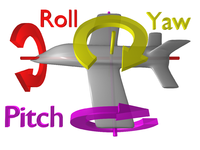Inertial measurement unit
This article needs additional citations for verification. (July 2007) |
An inertial measurement unit, or IMU, is an electronic device that measures and reports on a craft's velocity, orientation, and gravitational forces, using a combination of accelerometers and gyroscopes. IMUs are typically used to maneuver aircraft, including UAVs, among many others, and spacecraft, including shuttles, satellites and landers.
The IMU is the main component of inertial navigation systems used in aircraft, spacecraft, watercraft, and guided missiles among others. In this capacity, the data collected from the IMU's sensors allows a computer to track a craft's position, using a method known as dead reckoning.
How they work


An IMU works by detecting the current rate of acceleration using one or more accelerometers, and detects changes in rotational attributes like pitch, roll and yaw using one or more gyroscopes.
In a navigation system, the data reported by the IMU is fed into a computer, which calculates its current position based on velocity and time.[citation needed]
For example, if an IMU installed in an aeroplane were to detect that the craft traveled westward for 1 hour at an average speed of 500 miles per hour, then the guidance computer would deduce that the plane must be 500 miles west of its initial position. If combined with a computerized system of maps, the guidance system could use this method to show a pilot where the plane is located geographically, similar to a GPS navigation system — but without the need to communicate with any outside components, such as satellites. This method of navigation is called dead reckoning.
Disadvantages
A major disadvantage of using IMUs for navigation is that they typically suffer from accumulated error, including Abbe error. Because the guidance system is continually adding detected changes to its previously-calculated positions (see dead reckoning), any errors in measurement, however small, are accumulated from point to point. This leads to 'drift', or an ever-increasing difference between where the system thinks it is located, and the actual location.
For example, if an individual were blindfolded, moved in a series of directions, and then asked where they think they are, they would only be able to estimate their final position. The more a person were moved while blindfolded, the more inaccurate their guess of where they have ended up. IMUs work in a manner similar to that which human beings use to detect motion, and although they yield considerably more accurate motion sensing than a human being is able to perform, they are still not perfect, and their errors can accumulate in a similar way.
IMUs are normally only one component of a navigation system. Other systems are used to correct the inaccuracies that IMUs inevitably suffer, such as GPS, gravity sensors (for local vertical), external speed sensors (to compensate for velocity drift), a barometric system for altitude correction, and a magnetic compass.[citation needed]
Construction
The term IMU is widely used to refer to a box containing three accelerometers and three gyroscopes. The accelerometers are placed such that their measuring axes are orthogonal to each other. They measure inertial acceleration, also known as G-forces.[citation needed]
Three gyroscopes are placed in a similar orthogonal pattern, measuring rotational position in reference to an arbitrarily chosen coordinate system.[citation needed]
Uses
IMUs are used in vehicle-installed inertial guidance systems. Today almost every commercial or military water-going vessel has one.[citation needed] Most aircraft are also equipped with IMUs.
IMUs are also used alone on air- and spacecraft, in order to report inertial measurements to a pilot (whether he is in the cockpit or piloting by remote control). They are critical during space missions to maneuver manned or unmanned landers and other craft.
IMUs can, besides navigational purposes, serve as orientation sensors in the human field of motion. They are frequently used for sports technology (technique training), and animation applications. They are a competing technology for use in motion capture technology. An IMU is at the heart of the balancing technology used in the Segway Personal Transporter.
